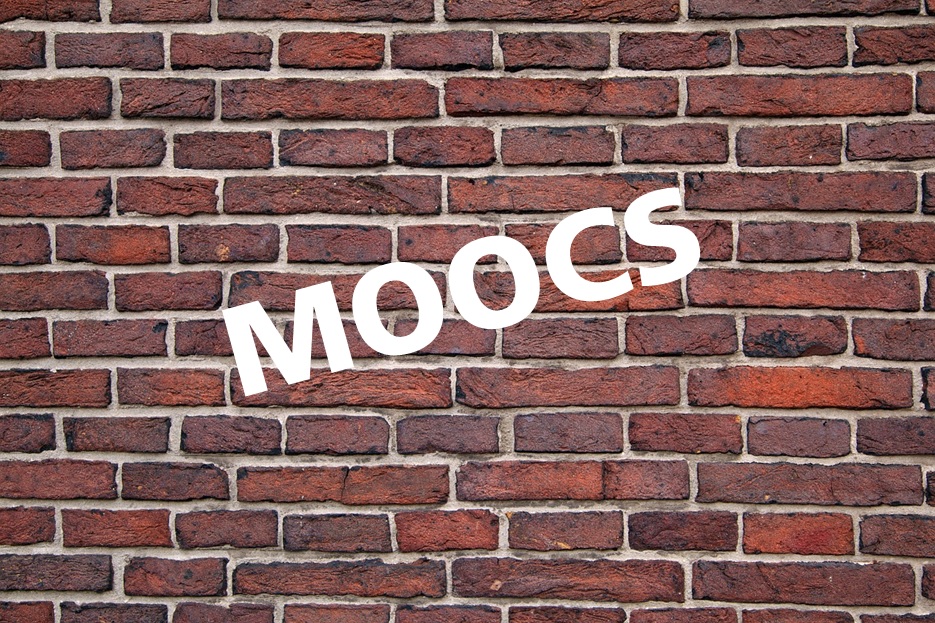Thoughtstorm
2015
Do MOOCs Really Break Some Walls?

“Only a wall divided him from those happy young contemporaries of his with whom he shared a common mental life; men who had nothing to do from morning till night but to read, mark, learn, and inwardly digest. Only a wall – but what a wall!” – Jude the Obscure, Thomas Hardy
Do MOOCs really break those walls?
I think the Internet itself demolishes those walls to a large extent. However, how big is the blow delivered by MOOCs?
Wall 1: Access and Affordability
MOOCs definitely break this barrier for many students across the world.
|
Non-affiliated, Not For Profits (Like Khan Academy) |
Not having a computer and Internet is where the access and affordability block begins in many countries. Several not for profit initiatives provide this basic access to students. |
|
Well Known Universities (Ex. Coursera, EdX etc.) |
Having access to good content is one of the biggest gifts of these MOOCs to students across the world. |
|
Connective MOOCs & Task Based MOOCs |
These types of MOOCs are conducted by a handful of professors currently. The subjects they cover are few. Since these MOOCs are about taking your learning in your own hands, anything learned from anywhere is a way that these MOOCs promote. |
Wall 2: Value of Self-Learning
Value of self-learning* is low, and it forms a big barrier to learning. Shouldn’t the primary task of open education be to increase the value/worth of “self-learning”? (It’s like the health industry trying to make people value healthier habits.) Let’s see how this has been done through MOOCs.
|
Non-affiliated, Not For Profits (Like Khan Academy) |
Salman Khan of Khan Academy brought the idea of the “flipped classroom” that caught up fast. It brilliantly promotes self-learning as valuable, and reverses the role of the teacher. |
|
Well Known Universities (Ex. Coursera, EdX etc.) |
The big, well-known universities, presenting courses on Coursera etc. have not proposed any pedagogical models that promote “self-learning” as valuable. They believe in star teachers delivering star content and learners learning sequentially following through with teachers. (teacher centric delivery) Maybe this is one wall they don’t want to touch. |
|
Connective MOOCs & Task Based MOOCs |
Connective MOOCs are all about self-learning, learning with peers and utilizing the network. The importance of “self-learning” is a part of the new pedagogical theories they propose and experiment with. |
Wall 3: Ownership of Content
Why is ownership of content important? Because the hand that owns the content rules the learning.
|
Non-affiliated, Not For Profits (Like Khan Academy) |
The content in Khan Academy is open, and it runs from teacher to student. With the flipped approach, learners decide their progress and pace, and the classroom helps them cope. |
|
Well Known Universities (Ex. Coursera, EdX etc.) |
The content is owned by the universities, and it comes with the individual brand of each professor and university. They deliver the course, and in many cases after the course is over, the videos are pulled down till the course starts again. How or why would anyone shut something that is online? Is it to establish ownership? |
|
Connective MOOCs & Task Based MOOCs |
The Internet, the people in the network, and the learners themselves own the content. Learners are encouraged to create more and more content and share it with the network. Content is in the hands of the learner. Support is provided by the network. |
Wall 4: World’s Perception of Students’ Learning Efforts
A great wall is other's perception of learning achieved on one’s own, outside of institutions. Most people worry whether what they’re learning on their own will have any value in the real world. Will it get them a job? Will it help them grow in their current job? Will it help them do better at school? How much do MOOCs help break this wall?
|
Non-affiliated, Not For Profits (Like Khan Academy) |
Khan Academy provides a way to test what you have learned. You can view your ipsative scores and your progress through a series of exercises, meticulously created, backed by data and presented to you and your teachers in a gamified platform. The “gaps in learning” are clearly visible for the student and teacher to work upon. |
|
Well Known Universities (Ex. Coursera, EdX etc.) |
University MOOCs seem to have the strongest wall here. The differentiation between the “real stuff”, that is, a university education and the video lectures of professors shared via MOOCs seems to amplify the wall. A common argument given by the owners of these MOOCs is that peer/expert interaction cannot be replicated online. Not true, if you look at how people are interacting across the Internet (or look at other MOOC types). Assessments in these MOOCs may cost you something (which may be fair). Or they may have assessments (peer reviewed exercises and scored questions) and provide a certificate to those who complete it. However, the bigger barrier is the value of the diploma/certificate you earn at the end of the MOOC. Is it of any value? Should this barrier always stay for universities to remain relevant? |
|
Connective MOOCs & Task Based MOOCs |
Building your digital footprint and having your efforts out there for everyone to see are the best resume you can create. The more value you generate online, the more value you develop for yourself. These MOOCs demolish this wall for those who are truly interested. |
*Self-learning means to take responsibility for your learning, learning how to learn, owning your curriculum, and owning your content.
Are Dropout Rates a big Wall for MOOCs? Click here to read more.
Contact us
Write to us and we'll get back to you soon. Or feel free to call us.
Phone: +91 99215 90789
Email: anchalmanocha@designstorm.in
Address: 103, Ilex Bliss, Veerbhadra Nagar, Baner,
Pune, Maharashtra, India 411 045.